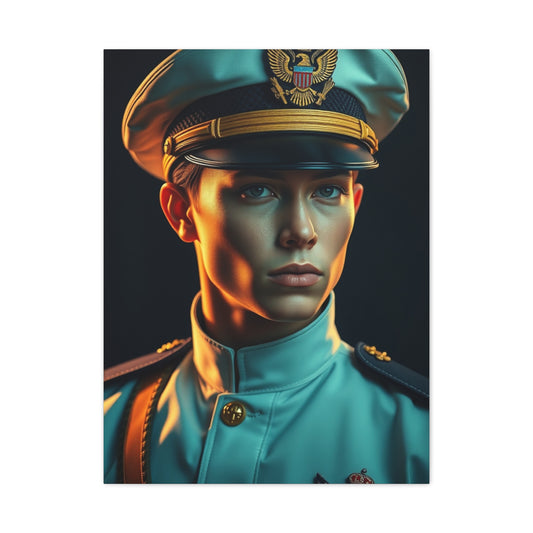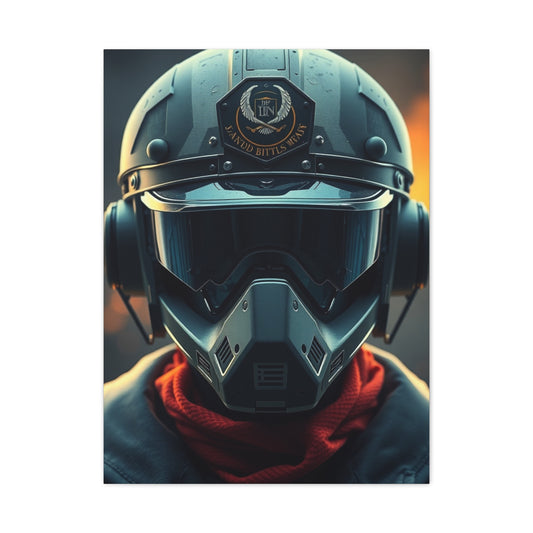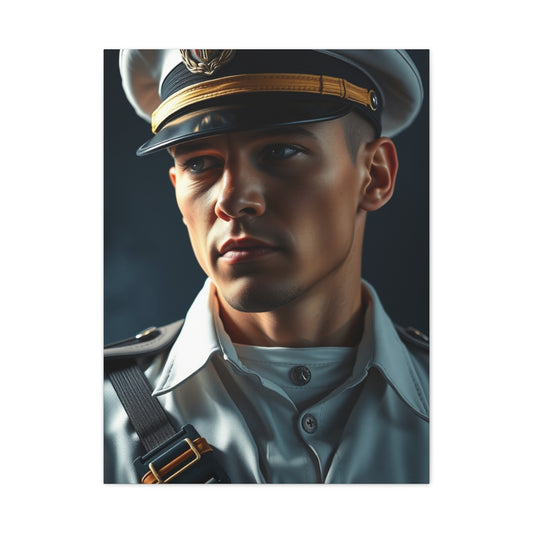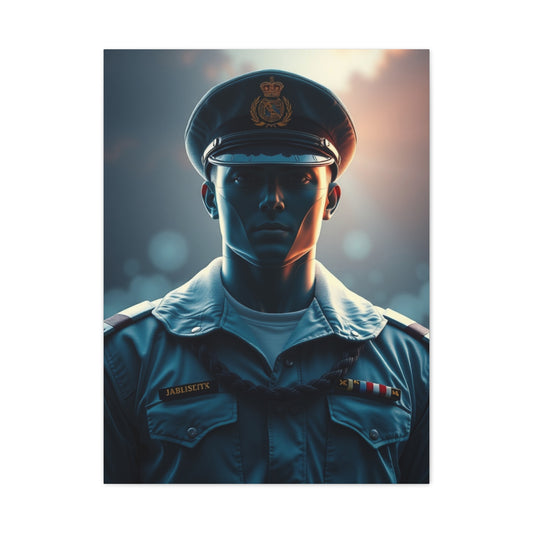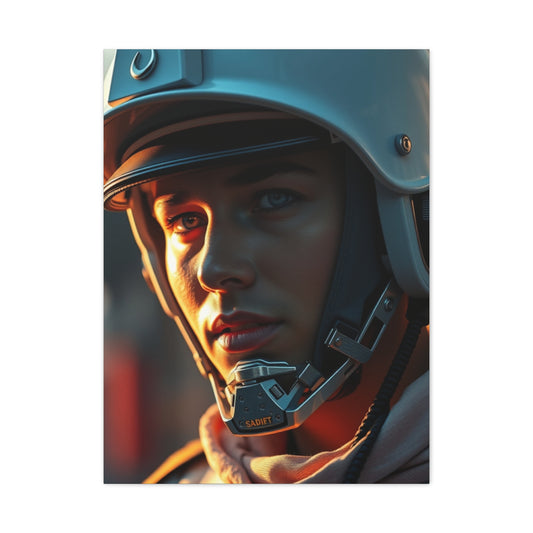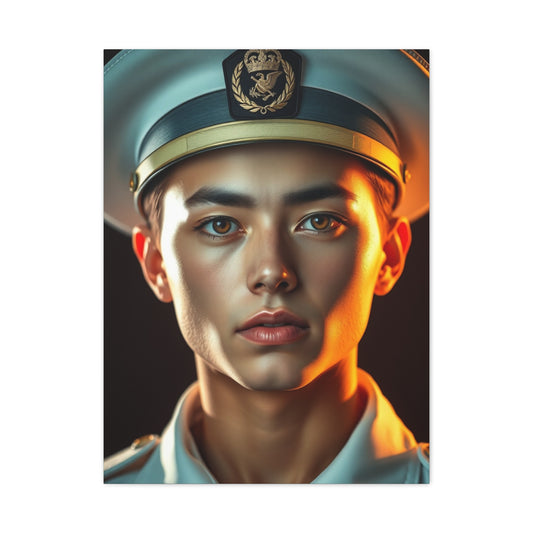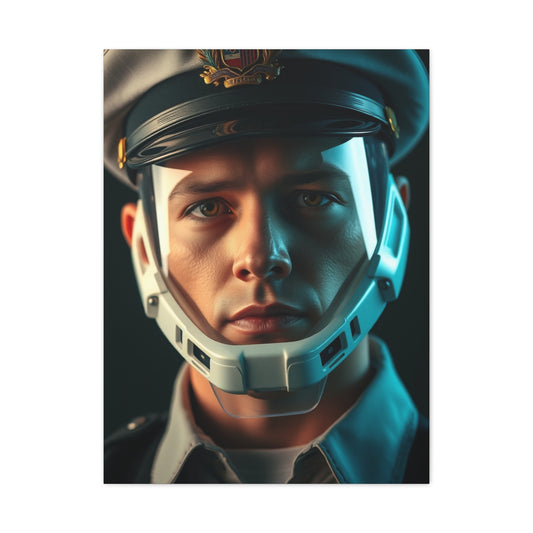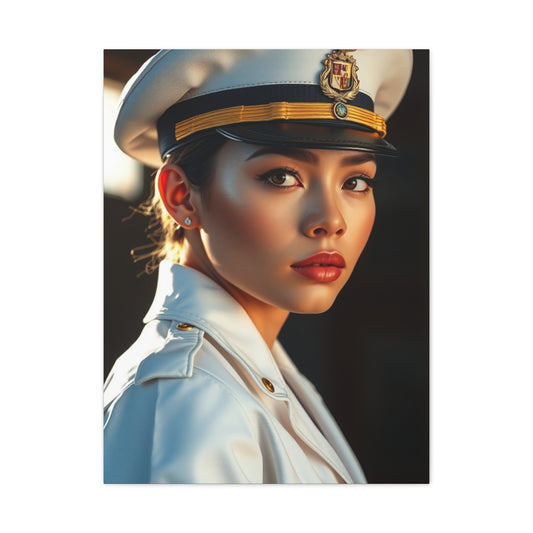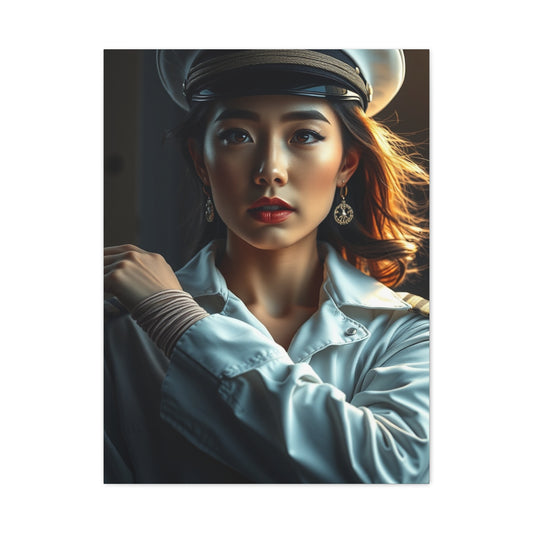Exploring Navy Military Wall Art: Your Guide to Maritime Heritage in Art
Navy military art serves as a powerful visual chronicle of maritime history, capturing pivotal moments that shaped nations and defined the course of civilization. These artistic expressions transcend mere decoration, functioning as historical documents that preserve the memory of naval battles, heroic actions, and the evolution of maritime warfare.
The relationship between naval art and history is intrinsically intertwined. When we examine paintings from the Dutch Golden Age, we witness not only the artistic mastery of painters like Willem van de Velde the Elder and Younger, but also gain insight into the naval supremacy that made the Netherlands a dominant maritime power during the 17th century. These works document the design and construction of warships from that era, showing details of rigging, armament, and naval tactics that would otherwise be lost to time.
Naval art has consistently served as a means of documenting significant maritime events. The Battle of Trafalgar, one of the most decisive naval engagements in history, has been immortalized through countless paintings, each offering different perspectives on the same monumental event. These works capture not only the drama and chaos of battle but also the technical aspects of naval warfare during the age of sail. Artists like J.M.W. Turner and Clarkson Stanfield created masterpieces that show the positioning of ships, the flow of battle, and the environmental conditions that influenced the outcome.
The documentation aspect of navy military art extends beyond major battles to include the daily life aboard naval vessels. Artists who sailed with expeditions created detailed records of naval uniforms, ship interiors, and the routines of maritime life. These works provide invaluable insights into the social hierarchy aboard ships, the conditions endured by sailors, and the evolution of naval protocol and traditions.
During the Age of Exploration, navy military art played a crucial role in documenting new lands and peoples encountered during maritime expeditions. Artists like Sydney Parkinson, who sailed with Captain Cook, created detailed illustrations of coastlines, indigenous peoples, and natural phenomena that provided European audiences with their first visual impressions of distant lands. These works served both artistic and scientific purposes, contributing to the expansion of geographical and anthropological knowledge.
The industrial revolution brought significant changes to naval warfare, and military art adapted to document these transformations. The transition from sail to steam power is beautifully captured in paintings that show paddle steamers alongside traditional sailing ships. Artists began depicting the smoke and steam of modern naval vessels, the changing silhouettes of warships, and the new tactics that emerged with industrial-age warfare.
World War I marked a significant shift in naval art, as artists began to focus more on the human cost of maritime warfare. Works from this period often depict the dangers faced by merchant sailors, the horror of submarine warfare, and the industrial scale of modern naval conflict. Official war artists like Charles Pears created powerful images that conveyed both the technological advancement of naval warfare and its devastating human impact.
The documentation of submarine warfare represents a unique challenge for naval artists, as much of this combat occurs beneath the surface. Artists have developed innovative ways to represent underwater warfare, using cross-sections, dramatic lighting, and symbolic elements to convey the tension and danger of submarine operations. These works help preserve the memory of a form of warfare that is largely invisible to surface observers.
Navy military art also reflects the changing role of women in maritime service. Early works typically showed women only as figures waving farewell from shore or as allegorical representations of victory or liberty. However, as women began serving in various naval capacities, artists began depicting their contributions to maritime defense. This evolution in subject matter reflects broader social changes and the expanding definition of naval service.
Key Themes in Maritime Military Art
Maritime military art has long been a powerful medium to capture the drama, strategy, and heroism of naval warfare. Rooted in centuries of seafaring tradition, this genre reflects not only the technical and tactical aspects of naval combat but also the cultural, emotional, and symbolic dimensions of life at sea. One of the key themes in maritime military art is the depiction of naval battles. These artworks immortalize moments of conflict where fleets clashed, cannons roared, and the fate of nations hung in the balance. Artists often focus on the chaos and intensity of battle—smoke-filled skies, blazing ships, and turbulent seas—conveying the violence and unpredictability of war at sea.
Another prominent theme is the valor and heroism of sailors and commanders. Portraits and scenes often highlight individual acts of bravery, leadership, and sacrifice, emphasizing the human element within the vast expanse of oceanic warfare. These artworks serve as tributes to the men and women who endured harsh conditions, navigated perilous waters, and fought against overwhelming odds.
Technological advancement is also a recurring theme. As naval technology evolved—from wooden sailing ships to ironclads and eventually to modern steel battleships and aircraft carriers—artists captured these changes, documenting the transformation of maritime warfare. This theme reflects not just military might but also industrial progress and innovation.
Finally, maritime military art often incorporates symbolism and nationalism, portraying flags, emblems, and naval insignia to evoke pride and patriotism. These works remind viewers of the navy’s crucial role in protecting sovereignty and projecting power, making them integral to a nation’s historical narrative and identity.
Together, these themes create a rich tapestry that honors maritime heritage, commemorates historical events, and celebrates the enduring spirit of those who serve on the seas.
Famous Naval Battles Depicted in Wall Art
Naval battles have fascinated artists for centuries, and many iconic confrontations have been immortalized in wall art, offering vivid windows into pivotal moments in maritime history. Among the most frequently depicted is the Battle of Trafalgar (1805). This decisive conflict during the Napoleonic Wars saw the British Royal Navy under Admiral Nelson defeat the combined fleets of France and Spain, ensuring British naval supremacy for over a century. Artworks often capture the dramatic intensity of the battle, with ships locked in combat amid billowing smoke and crashing waves. Nelson’s heroic leadership and ultimate sacrifice are central themes in these paintings.
Another famous battle is the Battle of the Chesapeake (1781), a crucial engagement during the American Revolutionary War. This clash prevented British reinforcements from reaching Yorktown, directly leading to American victory. Paintings of this battle emphasize strategic naval maneuvers and the importance of sea power in shaping the course of history.
The Battle of Jutland (1916), the largest naval battle of World War I, is another common subject. Depictions highlight the clash between the British Royal Navy’s Grand Fleet and the German High Seas Fleet. Artists focus on the dramatic interplay of firepower, steel warships, and the fog of war, underscoring the technological shift from sail to steel.
Lastly, the Battle of Midway (1942) stands as a landmark in World War II naval history. This aircraft carrier battle marked a turning point in the Pacific theater. Wall art portraying Midway often showcases the ferocity of air combat over the sea, the sinking of Japanese carriers, and the pivotal role of intelligence and strategy.
Navy Wall Art Captures Maritime Heritage
Navy wall art plays a crucial role in preserving and celebrating maritime heritage by visually narrating the stories of seafaring traditions, naval accomplishments, and cultural identity. Through evocative imagery, these artworks bring to life the experiences of sailors, the grandeur of naval vessels, and the ever-changing relationship between humanity and the sea.
One way navy art captures maritime heritage is by depicting everyday life aboard ships. Scenes showing sailors at work, navigating treacherous waters, or enduring storms provide insight into the challenges and camaraderie inherent in naval service. These intimate portrayals deepen our understanding of the human side of maritime history, reminding us that behind every ship and battle are individuals with stories of endurance and dedication.
Moreover, navy art frequently showcases historic ships and their design evolution, preserving the technological and aesthetic aspects of maritime craftmanship. These detailed images honor the engineering feats that enabled long voyages and military dominance, highlighting the craftsmanship and innovation of different eras.
Navy wall art also serves as a cultural touchstone, reflecting national pride and collective memory. By portraying key moments and symbols associated with a nation’s naval past, the art reinforces identity and continuity. Museums, military institutions, and private collectors often display such pieces to educate the public, inspire patriotism, and commemorate naval heroes.
Additionally, navy art contributes to maritime heritage by emphasizing the environmental and geographical context—depictions of vast oceans, harbors, and coastlines situate naval history within its natural setting. This connection underscores the dependence of naval power on mastery over the seas and respect for maritime ecosystems.
In sum, navy wall art functions as a visual archive, bridging past and present, educating and inspiring viewers, and ensuring that the legacy of maritime heritage remains vibrant and accessible.
Iconic Ships Featured in Navy Military Art
Certain naval vessels have achieved iconic status in history and art, symbolizing naval power, technological innovation, and historical significance. Navy military art frequently celebrates these ships, immortalizing their roles and aesthetics in compelling visual form.
The HMS Victory, Admiral Nelson’s flagship at the Battle of Trafalgar, is one of the most recognized ships in naval art. This majestic 18th-century warship is often depicted with intricate rigging, billowing sails, and vibrant battle scenes. Victory represents British naval dominance and the valor of its crew, making it a favorite subject for artists commemorating the age of sail.
Another iconic vessel is the USS Constitution, affectionately known as "Old Ironsides." Famous for its resilience during the War of 1812, this American frigate symbolizes endurance and national pride. Its representation in art often highlights the sturdy wooden hull and the dynamic action of naval engagements, reinforcing its legendary status.
The Bismarck, Germany’s formidable battleship during World War II, is another prominent figure in navy military art. Known for its power and tragic sinking, the Bismarck’s images evoke the technological leap to steel battleships and the strategic stakes of WWII naval warfare. Artists capture the sleek lines and menacing silhouette, emphasizing both strength and vulnerability.
Lastly, modern vessels like the USS Enterprise (CV-6), a highly decorated aircraft carrier from World War II, are celebrated in naval art for their role in transforming naval combat through air power. Depictions often focus on the carrier’s flight deck action, planes taking off, and the coordinated efforts of crew, illustrating the evolution of maritime military strategy.
Through these iconic ships, navy military art encapsulates the spirit of different eras, celebrating technological progress, strategic innovation, and the enduring legacy of naval forces across history.
Modern Trends in Navy Military Art
Contemporary navy military art is experiencing a renaissance driven by new mediums, changing perspectives, and evolving understanding of maritime warfare. Modern artists are pushing the boundaries of traditional naval art while maintaining respect for historical traditions and the fundamental purpose of honoring naval service.
Digital art has revolutionized the creation and distribution of navy military art. Artists now use sophisticated software to create highly detailed renderings of modern naval vessels, allowing for precise representation of complex systems and equipment. Digital painting enables artists to achieve photographic realism while maintaining artistic interpretation, creating works that serve both documentary and aesthetic purposes.
The integration of 3D modeling into artistic practice has opened new possibilities for representing naval subjects. Artists can create detailed virtual models of ships and then render them in various lighting conditions, weather scenarios, and tactical situations. This approach allows for the creation of historically accurate scenes that would be impossible to photograph or sketch from life.
Virtual reality is beginning to influence navy military art by creating immersive experiences that allow viewers to explore naval vessels and battle scenes in unprecedented detail. These interactive artworks represent a fusion of artistic vision with cutting-edge presentation methods, offering audiences new ways to engage with naval history and culture.
Contemporary artists are increasingly focusing on the human element of naval service, moving beyond traditional ship portraits to explore the personal experiences of sailors and naval personnel. This trend reflects broader artistic movements toward individual narrative and personal story within larger historical contexts.
Environmental consciousness has emerged as a significant theme in modern navy military art. Artists are creating works that explore the relationship between naval operations and marine ecosystems, addressing topics such as ocean pollution, climate change impacts on naval operations, and the environmental responsibility of maritime forces.
The representation of modern naval personnel reflects changing demographics within naval services. Contemporary artists are depicting the diversity of modern naval forces, including increased representation of women, minorities, and international personnel serving aboard naval vessels. This evolution in subject matter reflects the changing face of naval service in the 21st century.
Abstract and conceptual approaches to navy military art are gaining recognition as artists explore symbolic representations of maritime themes. Rather than focusing solely on realistic depictions of ships and battles, these artists use color, form, and composition to convey the emotional and psychological aspects of naval service.
Mixed media approaches are becoming increasingly popular among navy military artists. These works might combine traditional painting or drawing with photography, digital elements, found objects, or even pieces of actual naval equipment. This approach allows artists to create textured, layered works that reference both historical tradition and contemporary artistic practice.
Installation art focusing on naval themes has gained prominence in galleries and museums. These large-scale works might recreate sections of naval vessels, use sound and light to simulate shipboard environments, or create immersive experiences that help viewers understand the conditions and challenges of naval service.
The influence of video game aesthetics on navy military art represents an interesting convergence of entertainment and artistic expression. Some contemporary artists draw inspiration from naval-themed games, incorporating their visual language and perspective into fine art works that appeal to younger audiences while maintaining artistic integrity.
Street art and murals featuring navy military themes have become increasingly common, particularly in port cities and areas with strong naval traditions. These public artworks serve to connect naval history with contemporary urban culture, making maritime heritage accessible to broader audiences.
Photography has evolved as a significant medium within navy military art, with photographers creating artistic documentation of modern naval operations. These works go beyond simple documentation to explore composition, lighting, and symbolic content that elevates them to the level of fine art.
The use of infrared and other specialized photographic techniques has created new visual languages for representing naval subjects. These approaches can reveal hidden aspects of naval vessels and operations while creating striking visual effects that challenge traditional perceptions of maritime subjects.
Contemporary navy military art increasingly addresses global perspectives on maritime power. Artists from various nations are creating works that reflect their own naval traditions while engaging with international themes of maritime security, cooperation, and conflict.
The representation of cyber warfare and electronic systems in navy military art presents unique challenges for contemporary artists. These invisible but crucial aspects of modern naval operations require creative approaches to visualization, leading to innovative artistic solutions that make abstract concepts visually compelling.
Social media has transformed how navy military art is created, shared, and consumed. Artists can now reach global audiences instantly, receive immediate feedback, and collaborate with other artists and naval personnel from around the world. This connectivity has led to new forms of collaborative artistic practice and cross-cultural exchange.
Collecting Navy Military Art: What to Look For
Building a meaningful collection of navy military art requires knowledge, patience, and a clear understanding of what constitutes quality and authenticity in this specialized field. Successful collectors develop expertise in historical context, artistic merit, and market dynamics while maintaining focus on their personal interests and collecting goals.
Authentication represents the most critical aspect of collecting navy military art. Original works by recognized naval artists command premium prices, but the market contains numerous reproductions, prints, and works of questionable attribution. Collectors must learn to distinguish between original paintings, authorized prints, and unauthorized reproductions. Documentation such as provenance records, artist signatures, and expert opinions can help establish authenticity.
Historical significance greatly influences the value and desirability of navy military art. Works that document important naval battles, significant ships, or notable naval figures typically hold more value than generic maritime scenes. However, historical significance must be balanced against artistic merit, as a well-executed painting of a lesser-known subject may be more valuable than a poorly executed work depicting a famous battle.
Condition assessment is crucial when evaluating navy military art for collection. Paintings may suffer from various forms of deterioration including fading, cracking, water damage, or previous restoration attempts. Understanding how these conditions affect value and whether restoration is feasible helps collectors make informed decisions about potential acquisitions.
The reputation and skill of the artist significantly impact the collectibility of navy military art. Established naval artists like Montague Dawson, Charles Robert Patterson, or Geoff Hunt command higher prices due to their recognized expertise and artistic ability. However, collectors should not overlook lesser-known artists whose work may offer better value or represent regional artistic traditions.
Size and format considerations affect both the aesthetic impact and practical aspects of collecting navy military art. Large-scale works create dramatic impact but require significant display space and may be more difficult to transport or store. Smaller works may be more affordable and practical but might lack the visual presence of larger pieces.
Subject matter preferences vary among collectors, with some focusing on specific naval services, historical periods, or types of vessels. Battle scenes remain popular among collectors, but portraits of individual ships, naval aviation subjects, and submarine warfare are also actively collected. Developing expertise in a particular area allows collectors to make more informed decisions and recognize exceptional examples.
Original period works versus contemporary naval art presents different collecting opportunities. Historical works from the 18th and 19th centuries offer direct connections to naval history but are increasingly rare and expensive. Contemporary works by living artists may be more affordable and offer opportunities to interact with the creators while supporting ongoing artistic production.
Documentation and research capabilities distinguish serious collectors from casual buyers. Maintaining detailed records of acquisitions, including purchase information, condition reports, and historical research, enhances the value of a collection and facilitates future sales or donations. Digital photography and database management help organize collection information.
Conservation and preservation knowledge protects the long-term value of navy military art collections. Understanding proper framing, lighting, climate control, and handling procedures prevents damage and maintains artwork condition. Establishing relationships with qualified conservators ensures proper care when restoration or conservation treatment becomes necessary.
Budget considerations must balance acquisition goals with financial reality. Entry-level collectors might focus on prints, lithographs, or works by lesser-known artists while gradually building expertise and financial resources for more significant acquisitions. Setting realistic budgets prevents overextension while allowing for meaningful collection development.
Market trends and pricing patterns help collectors time acquisitions and understand value fluctuations. Navy military art markets can be influenced by factors such as naval anniversaries, museum exhibitions, or popular media attention to naval history. Understanding these patterns helps collectors identify buying opportunities and avoid overpaying during market peaks.
Dealer and auction house relationships provide access to quality navy military art and expert knowledge. Reputable dealers often provide authentication guarantees, condition reports, and educational information that benefits collectors. Auction houses offer opportunities to acquire rare or significant works but require careful research and bidding strategies.
Specialization versus diversification strategies affect collection development approaches. Some collectors focus narrowly on specific artists, ships, or historical periods, developing deep expertise in chosen areas. Others prefer diverse collections that represent various aspects of naval art and history. Both approaches have merit depending on collector goals and interests.
Display and storage planning ensures that collected works can be properly enjoyed and preserved. Considerations include available wall space, lighting conditions, security measures, and climate control. Some collectors rotate displays to accommodate larger collections while ensuring all works are properly stored when not exhibited.
Navy Military Art in Public Monuments and Memorials
Public monuments and memorials featuring navy military art serve as powerful expressions of national pride, historical memory, and tribute to naval service. These permanent installations reach audiences far beyond traditional art collectors or museum visitors, making maritime heritage accessible to entire communities while honoring the sacrifices and achievements of naval personnel.
Naval monuments often incorporate sculptural elements that represent various aspects of maritime service. Bronze figures of sailors, officers, and naval aviators capture the human element of naval service while providing focal points for public remembrance. These sculptures must balance artistic expression with historical accuracy, creating works that resonate emotionally while maintaining respect for military tradition.
Memorial walls and plaques featuring navy military art serve to commemorate specific naval units, battles, or periods of service. These installations often combine textual information with artistic elements such as relief sculptures, mosaics, or painted murals that help visitors understand and connect with naval history. The challenge lies in creating works that are both informative and visually compelling.
Ship models and replicas incorporated into public memorials provide tangible connections to naval history. These three-dimensional artworks allow visitors to appreciate the scale, complexity, and craftsmanship of naval vessels while serving as centerpieces for memorial sites. Accurate reproduction requires extensive research and skilled craftsmanship to achieve historical authenticity.
Eternal flames and water features integrated with navy military art create symbolic representations of sacrifice and continuity. These elements add movement and sensory engagement to static artworks while providing metaphorical connections to the maritime environment in which naval personnel serve.
Public murals depicting naval scenes bring military art to urban environments and community spaces. These large-scale works can transform ordinary walls into compelling historical narratives while making naval heritage visible to daily commuters and residents. Community involvement in mural projects can strengthen connections between naval history and local identity.
Memorial gardens incorporating navy military art create contemplative spaces for reflection and remembrance. Landscaping elements complement artistic installations while providing peaceful environments for visitors to consider the significance of naval service. The integration of native plants and maritime-themed design elements reinforces connections to regional naval history.
Interactive elements in naval monuments engage visitors and provide educational opportunities. Touch screens, audio systems, and augmented reality features can supplement traditional artistic elements with additional information, personal stories, and multimedia content that enhances understanding and emotional connection.
Maintenance and conservation of public navy military art presents ongoing challenges for monument administrators. Exposure to weather, vandalism, and normal wear requires regular attention to preserve both artistic and historical value. Establishing maintenance endowments and conservation protocols ensures long-term preservation of these important cultural resources.
Community involvement in creating and maintaining naval monuments strengthens local connections to maritime heritage. Volunteer organizations, veterans groups, and civic associations often play crucial roles in fundraising, design input, and ongoing care of memorial installations. This community engagement helps ensure that monuments remain relevant and valued by the populations they serve.
Accessibility considerations in memorial design ensure that navy military art can be appreciated by visitors with various physical abilities. Universal design principles, including wheelchair accessibility, tactile elements for vision-impaired visitors, and clear sight lines, make memorial sites welcoming to all community members.
Lighting design for naval monuments extends viewing hours while creating dramatic effects that enhance artistic impact. Carefully planned illumination can highlight sculptural details, create mood and atmosphere, and ensure that memorials remain visible and impressive during evening hours.
Security measures must balance protection of artistic installations with public accessibility. Vandalism, theft, and damage represent ongoing concerns for public navy military art, requiring thoughtful design solutions that discourage destructive behavior while maintaining open access for legitimate visitors.
Educational programming associated with naval monuments enhances their cultural impact and community value. Guided tours, school programs, and special events help connect artistic installations with broader educational goals while providing opportunities for veterans and naval personnel to share their experiences.
Fundraising for naval monument projects requires coordination between various stakeholders including veterans organizations, government agencies, corporate sponsors, and individual donors. Successful projects often combine private philanthropy with public support while maintaining focus on artistic quality and historical accuracy.
Iconic Navy Battles Depicted in Art
The artistic representation of decisive naval battles has created some of the most powerful and enduring images in military art. These works not only capture the drama and significance of maritime combat but also serve as historical documents that preserve the memory of pivotal moments that shaped national destinies and global power structures.
The Battle of Trafalgar stands as perhaps the most frequently depicted naval engagement in art history. This decisive 1805 confrontation between the British Royal Navy and the combined French and Spanish fleets has inspired countless artistic interpretations, each offering unique perspectives on the battle's progression and significance. Artists have focused on various aspects of the engagement, from the initial approach of the fleets to the death of Admiral Nelson aboard HMS Victory.
J.M.W. Turner's painting "The Battle of Trafalgar" demonstrates how artistic interpretation can capture both the physical reality and emotional impact of naval combat. Turner's use of dramatic lighting and atmospheric effects conveys the confusion and violence of battle while maintaining focus on the human drama unfolding aboard the engaged vessels. The painting's composition draws viewers into the action while providing clear visual hierarchy that emphasizes key moments in the battle's development.
The Spanish Armada's defeat in 1588 has been immortalized through numerous artistic works that celebrate English naval victory and the preservation of Protestant England. These paintings often emphasize the role of weather and divine intervention in the Spanish defeat, reflecting the religious and political context of the conflict. Artists have depicted various stages of the campaign, from the initial sighting of the Spanish fleet to the final pursuit of damaged vessels along the Scottish and Irish coasts.
American naval victories during the War of 1812 provided rich subject matter for artists celebrating the young nation's maritime capabilities. The frigate duels between USS Constitution and various British vessels have been extensively depicted, with artists emphasizing the technological equivalence and fighting spirit that allowed American ships to compete successfully against the world's dominant navy. These works served both artistic and propaganda purposes, reinforcing American national identity during a critical period of development.
The Battle of Hampton Roads in 1862 marked the dawn of ironclad warfare and has been depicted by artists seeking to capture this revolutionary moment in naval history. The engagement between USS Monitor and CSS Virginia presented unique visual challenges, as these vessels bore little resemblance to traditional sailing warships. Artists developed new visual languages to represent steam-powered, armored vessels while maintaining the dramatic impact expected from naval combat art.
World War I submarine warfare created new subjects for naval artists and presented unique representational challenges. The invisible nature of submarine operations required creative approaches to visualization, with artists developing techniques to suggest underwater combat through surface effects, debris fields, and dramatic lighting. The sinking of passenger vessels like Lusitania provided emotionally charged subject matter that influenced public opinion and artistic interpretation.
The attack on Pearl Harbor has been extensively depicted by artists seeking to capture both the tactical surprise achieved by Japanese forces and the heroic response of American personnel. These works often emphasize the contrast between peaceful Sunday morning conditions and the sudden violence of aerial attack. Artists have explored various perspectives, from the attacking aircraft to the experiences of personnel aboard the targeted vessels.
The Battle of Midway represents a turning point in Pacific naval warfare and has inspired artistic works that attempt to convey the complex, multi-day engagement involving aircraft carriers, land-based aviation, and surface vessels across vast ocean distances. Artists have focused on various aspects of the battle, from the tension aboard carriers during flight operations to the dramatic moments when crucial tactical decisions determined the outcome.
The D-Day landings involved massive naval operations that provided rich subject matter for military artists. These works often emphasize the scale of the Allied naval force while capturing individual moments of heroism and sacrifice during the amphibious assault. Artists have depicted various aspects of the operation, from the preparation of invasion fleets to the support provided by naval gunfire during the beach assaults.
The Battle of Leyte Gulf, one of the largest naval engagements in history, challenged artists to represent the complexity of modern naval warfare involving multiple task forces operating across hundreds of miles of ocean. These artistic works often focus on specific actions within the larger battle, such as the last battleship engagement in naval history or the desperate attacks by Japanese surface forces against American carriers.
Contemporary conflicts have provided new subjects for naval military artists, though the nature of modern warfare often lacks the visual drama of historical engagements. Artists depicting modern naval operations must find ways to represent the sophistication of contemporary weapons systems and the coordination of joint operations while maintaining emotional impact and historical significance.
Role of Navy Military Art in Boosting Morale
Navy military art has historically played a crucial role in maintaining and enhancing morale among naval personnel, their families, and the broader civilian population during times of war and peace. This artistic tradition serves multiple psychological and social functions that extend far beyond mere decoration, creating powerful connections between individual service members and their institutional identity.
Inspirational imagery depicting naval heroism and achievement provides powerful motivation for service members facing the challenges and dangers of maritime duty. Paintings showing successful naval actions, heroic individual conduct, and the triumph of naval forces over adversity create visual narratives that reinforce positive aspects of military service while establishing role models for emulation.
Unit pride and esprit de corps are significantly enhanced through art that celebrates specific ships, squadrons, or naval commands. Custom paintings depicting particular vessels or units create focal points for group identity while honoring the history and achievements of specific organizations. These works often become cherished symbols that travel with units through deployments and reassignments.
Memorial art honoring fallen comrades serves crucial psychological functions in helping naval personnel process loss while maintaining mission focus. These works provide opportunities for collective grief and remembrance while reinforcing the significance of military service and the values for which personnel have sacrificed. Memorial art helps maintain connections with deceased shipmates while supporting ongoing operational effectiveness.
Family support through navy military art helps maintain connections between deployed personnel and their loved ones at home. Artistic depictions of naval life help family members understand and appreciate the environment in which their service members work while creating shared visual references that facilitate communication and emotional connection across distance and deployment separations.
Recreational and therapeutic benefits of creating and viewing navy military art provide stress relief and creative outlets for naval personnel. Art programs aboard ships and at shore installations offer opportunities for creative expression while building community among participants. The process of creating art provides meditation-like benefits that help personnel manage deployment stress and operational pressures.
Historical continuity represented through naval art helps current personnel connect with the broader traditions and heritage of naval service. Works depicting historical naval figures, battles, and achievements create links between past and present that reinforce institutional values while providing perspective on current challenges and opportunities.
Civilian support for naval operations is enhanced through public display of navy military art that educates audiences about naval missions while building appreciation for military service. These works help bridge the gap between military and civilian communities by making naval operations more accessible and understandable to general audiences.
Diplomatic and international relations benefit from navy military art that celebrates cooperation, joint operations, and shared maritime heritage among allied nations. Exchange of artistic works between naval services creates cultural connections that support broader strategic relationships while demonstrating mutual respect and professional admiration.
Training and educational enhancement through art helps personnel understand complex concepts, historical lessons, and operational procedures. Visual representations of tactical concepts, ship systems, and historical examples provide memory aids and conceptual frameworks that support professional development and operational effectiveness.
Recruiting and retention benefits result from navy military art that presents naval service in positive, appealing contexts. Artistic works that emphasize adventure, professional development, technological sophistication, and camaraderie help attract potential recruits while encouraging current personnel to continue their service careers.
Leadership inspiration drawn from naval art depicting exemplary command performance provides guidance and motivation for officers and senior enlisted personnel. These works establish standards of conduct and decision-making while offering historical examples of effective leadership under challenging circumstances.
Conclusion
Maritime military art serves as a powerful window into the complex and captivating world of naval warfare, capturing not only the physical might of fleets and vessels but also the rich heritage and human stories behind them. Through the vivid portrayal of key themes such as naval battles, heroism, technological progress, and national pride, this genre of art preserves and celebrates the enduring legacy of maritime history in ways that words alone often cannot achieve.
The depiction of famous naval battles, from Trafalgar to Midway, offers more than just dramatic visuals—it immortalizes decisive moments that shaped the fate of nations and altered the course of history. These artworks allow us to experience the tension, strategy, and chaos of combat at sea, reminding us of the bravery and sacrifice of those who fought on turbulent waters. By preserving these battles in paint, print, or sculpture, artists create a bridge between past and present, ensuring that these pivotal events remain alive in collective memory.
Navy wall art goes beyond mere historical documentation; it captures the essence of maritime heritage by portraying the everyday lives of sailors, the evolution of naval vessels, and the cultural significance of naval power. These works function as cultural artifacts that educate, inspire, and foster a deep appreciation for the human spirit and ingenuity that have propelled seafaring nations forward. Whether showing a crew battling a storm, a meticulously detailed ship design, or symbolic naval insignia, maritime military art connects us to the stories and traditions that form the backbone of naval identity.
Central to this artistic tradition are the iconic ships themselves—symbols of strength, innovation, and endurance. From the majestic HMS Victory to the resilient USS Constitution, and from the formidable Bismarck to the pioneering USS Enterprise, these vessels embody the technological advancements and strategic shifts that have defined naval warfare over the centuries. Their depictions celebrate not only their physical grandeur but also their roles as bearers of national pride and maritime power.
In an age where technology continues to evolve and naval strategies adapt, maritime military art remains a vital tribute to the past while inspiring future generations. It fosters a sense of connection to the sea and its history, reminding us that beneath the steel and sails lie stories of courage, sacrifice, and resilience. These visual narratives encourage us to value and protect our maritime heritage, appreciating the oceans not just as battlefields but as vital realms of exploration, trade, and human endeavor.
Ultimately, maritime military art is much more than decoration—it is a profound homage to the harmony between man, machine, and nature on the vast stage of the sea. It invites us to reflect on the enduring legacy of naval history and to honor the spirit of those who have sailed, fought, and dreamed upon the waters that connect the world.

